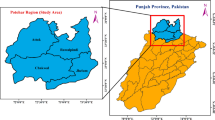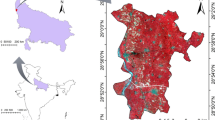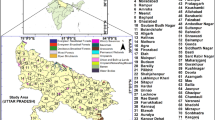Abstract
The emergence of remote sensing technologies and availability of satellite data over three decades have facilitated to monitor and understand the agricultural systems in many intensive agricultural regions. Here, we performed a comprehensive study on utilization of multi-temporal satellite data (i.e., Landsat-8 and MODIS) for wheat acreage and yield estimation during winter season (2016–2017) over the Sahibganj District in Jharkhand (India). Phenological variables were derived using the time-series normalized difference vegetation index (NDVI), which helps to understand the phenological transitions of wheat. The NDVI profile was used to derive rules for decision tree classifier to map the acerage of wheat. The key findings indicate that the acerage of wheat was estimated as ~3870 ha. Further, the long-term wheat statistics data were used to derive a yield model. Based on this model, wheat production was predicted as ~4523 t for the winter season 2016–2017, while, the mean was 3482 t. Predicted wheat yield was as ~1.17 t/ha, which was underestimated by 0.07 t/ha. Thus, it can be concluded that the accuracy of yield prediction depends on the precision of wheat acerage map derived from remote sensing data. A significant challenge for accurate acerage mapping could be the coarser spatial resolution of satellite data as the average plot sizes of Indian farmers can be far smaller than pixel sizes of the satellite data. Nevertheless, this comprehensive case study inferred that satellite-derived wheat acerage can be preferred to predict yield instead of traditional-based survey estimates.








Similar content being viewed by others
References
Atzberger C (2013) Advances in remote sensing of agriculture: context description, existing operational monitoring systems and major information needs. Remote Sens 5:949–981. https://doi.org/10.3390/rs5020949
Baby A, Shekh AM (2005) Field calibration and evaluation of crop simulation model InfoCrop to estimate wheat yields. J Agrometeorol 7:199–207
Bolton DK, Friedl MA (2013) Forecasting crop yield using remotely sensed vegetation indices and crop phenology metrics. Agric For Meteorol 173:74–84. https://doi.org/10.1016/j.agrformet.2013.01.007
Brown ME, de Beurs KM, Marshall M (2012) Global phenological response to climate change in crop areas using satellite remote sensing of vegetation, humidity and temperature over 26 years. Remote Sens Environ 126:174–183. https://doi.org/10.1016/j.rse.2012.08.009
Chen Z, Li S, Ren J et al (2008) Monitoring and management of agriculture with remote sensing. In: Advances in Land Remote Sensing. Springer, Dordrecht, pp 397–421
Directorate of Economics & Statistics, DAC&FW (DES) (2018) Agricultural statistics at a glance. Department of agriculture, cooperation and farmers welfare, ministry of agriculture and farmers welfare. Government of India, Government of India https://eands.dacnet.nic.in/Default.htm. Accessed 20 April 2018
Duncan JMA, Dash J, Atkinson PM (2015) The potential of satellite-observed crop phenology to enhance yield gap assessments in smallholder landscapes. Front Environ Sci 3:1–16. https://doi.org/10.3389/fenvs.2015.00056
Durgun Y, Gobin A, Van De Kerchove R, Tychon B (2016) Crop area mapping using 100-m Proba-V time series. Remote Sens 8:585. https://doi.org/10.3390/rs8070585
Duveiller G, Defourny P (2010) A conceptual framework to define the spatial resolution requirements for agricultural monitoring using remote sensing. Remote Sens Environ 114:2637–2650. https://doi.org/10.1016/j.rse.2010.06.001
Friedl MA, Brodley CE (1997) Decision tree classification of land cover from remotely sensed data. Remote Sens Environ 61:399–409. https://doi.org/10.1016/S0034-4257(97)00049-7
Galford GL, Mustard JF, Melillo J et al (2008) Wavelet analysis of MODIS time series to detect expansion and intensification of row-crop agriculture in Brazil. Remote Sens Environ 112:576–587. https://doi.org/10.1016/j.rse.2007.05.017
Ganguly S, Friedl MA, Tan B et al (2010) Land surface phenology from MODIS: characterization of the collection 5 global land cover dynamics product. Remote Sens Environ 114:1805–1816. https://doi.org/10.1016/j.rse.2010.04.005
González-Gómez L, Campos I, Calera A (2018) Use of different temporal scales to monitor phenology and its relationship with temporal evolution of normalized difference vegetation index in wheat. J Appl Remote Sens 12:1. https://doi.org/10.1117/1.JRS.12.026010
Haldar AK, Srivastava R, Thampi CJ, Sarkar D, Singh DS, Sehgal J, Velayutham M (1996) Soils of Bihar for optimizing land use (soils of India series). National Bureau of soil Survey and land use planning, Nagpur, p 70
Hao P, Wang L, Niu Z (2015) Comparison of hybrid classifiers for crop classification using normalized difference vegetation index time series: a case study for major crops in North Xinjiang, China. PLoS One 10:e0137748. https://doi.org/10.1371/journal.pone.0137748
Huete A, Didan K, Miura T et al (2002) Overview of the radiometric and biophysical performance of the MODIS vegetation indices. Remote Sens Environ 83:195–213. https://doi.org/10.1016/S0034-4257(02)00096-2
Jharkhand Economic Survey (JES) (2018) Jharkhand economic survey 2018-19, planning cum finance department, centre for fiscal studies, government of Jharkhand. https://financejharkhand.gov.in/pdf/JES_2018_19_ebook.pdf. Accessed 12 March 2019
Jiang Z, Huete AR, Chen J et al (2006) Analysis of NDVI and scaled difference vegetation index retrievals of vegetation fraction. Remote Sens Environ 101:366–378. https://doi.org/10.1016/j.rse.2006.01.003
Kalra N, Aggarwal PK, Singh AK, et al (2006) Methodology for national wheat yield forecast using wheat growth model, WTGROWS, and remote sensing inputs. In: Kuligowski RJ, Parihar JS, Saito G (eds) In Proc. SPIE 6411, agriculture and hydrology applications of remote sensing. 641106. https://doi.org/10.1117/12.697698
Kantakumar LN, Neelamsetti P (2015) Multi-temporal land use classification using hybrid approach. Egypt J Remote Sens Space Sci 18:289–295. https://doi.org/10.1016/j.ejrs.2015.09.003
Kastens J, Kastens T, Kastens D et al (2005) Image masking for crop yield forecasting using AVHRR NDVI time series imagery. Remote Sens Environ 99:341–356. https://doi.org/10.1016/j.rse.2005.09.010
Konecny G (2003) Geoinformation: remote sensing, photogrammetry and geographic information systems. Taylor & Francis
Krishnan P, Sharma RK, Dass A et al (2016) Web-based crop model: web InfoCrop—wheat to simulate the growth and yield of wheat. Comput Electron Agric 127:324–335. https://doi.org/10.1016/j.compag.2016.06.008
Lobell DB, Asner GP (2004) Cropland distributions from temporal unmixing of MODIS data. Remote Sens Environ 93:412–422. https://doi.org/10.1016/j.rse.2004.08.002
Lobell DB (2013) The use of satellite data for crop yield gap analysis. Field Crop Res 143:56–64. https://doi.org/10.1016/j.fcr.2012.08.008
Mohabey DP, Sharma NK, Kumar A (2015) Change detection in LU/LC of Sahibganj district, Jharkhand, India using remote sensing & GIS. IJARSGG 3(2):59–70
Moulin S, Kergoat L, Viovy N, Dedieu G, (1997) Global-Scale assessment of vegetation phenology using NOAA/AVHRR satellite measurements. J Climate 10:1154–1170
Nagy A, Feher J, Tamas J (2018) Wheat and maize yield forecasting for the Tisza river catchment using MODIS NDVI time series and reported crop statistics. Comput Electron Agric 151:41–49. https://doi.org/10.1016/j.compag.2018.05.035
Pal M, Mather PM (2001) Decision tree based classification of remotely sensed data. In Proceedings of the 22nd Asian Conference on Remote Sensing (ACRS), Singapore, 5–9 November 2001. Centre for Remote Imaging, Sensing and Processing (CRISP), National University of Singapore, Singapore Institute of Surveyors and Valuers (SISV), Asian Association on Remote Sensing (AARS), Singapore, pp 245–248
Palchowdhuri Y, Valcarce-Diñeiro R, King P, Sanabria-Soto M (2018) Classification of multi-temporal spectral indices for crop type mapping: a case study in Coalville, UK. J Agric Sci 156:24–36. https://doi.org/10.1017/S0021859617000879
Pan Y, Li L, Zhang J et al (2012) Winter wheat area estimation from MODIS-EVI time series data using the crop proportion phenology index. Remote Sens Environ 119:232–242. https://doi.org/10.1016/j.rse.2011.10.011
Panda SS, Hoogenboom G, Paz JO (2010) Remote sensing and geospatial technological applications for site-specific management of fruit and nut Crops: a review. Remote Sens 2:1973–1997. https://doi.org/10.3390/rs2081973
Parida BR (2006) Analysing the effect of severity and duration of agricultural drought on crop performance using Terra/MODIS satellite data and meteorological data. Dissertation, The International Institute for Geo-Information Science and Earth Observation
Parida BR, Collado WB, Borah R et al (2008a) Detecting drought-prone areas of rice agriculture using a MODIS-derived soil moisture index. GI Sci Remote Sens 45:109–129. https://doi.org/10.2747/1548-1603.45.1.109
Parida BR, Oinam B, Patel NR et al (2008b) Land surface temperature variation in relation to vegetation type using MODIS satellite data in Gujarat state of India. Int J Remote Sens 29:4219–4235. https://doi.org/10.1080/01431160701871096
Parihar JS (2016) FASAL concept in meeting the requirements of assessment and forecasting crop production affected by extreme weather events. Mausam 67(1):93–104
Parmar RS, Rajarathinam A, Patel HK, Patel KV (2016) Statistical modeling on area, production and productivity of cotton (Gossypium spp.) crop for Ahmedabad region of Gujarat state. J Pure Appl Microbiol 10:751–759
Patel NR, Bhattacharjee B, Mohammed AJ et al (2006) Remote sensing of regional yield assessment of wheat in Haryana, India. Int J Remote Sens 27:4071–4090. https://doi.org/10.1080/01431160500377188
Punia M, Joshi PK, Porwal MC (2011) Decision tree classification of land use land cover for Delhi, India using IRS-P6 AWiFS data. Expert Syst Appl 38:5577–5583
Reed BC, Schwartz MD, Xiao X (2003) Remote sensing phenology. In: Phenology of ecosystem processes: applications in global change research. Springer, New York, pp 365–381
Saxena R, Bhardwaj V, Kalra N (2006) Simulation of wheat yield using WTGROWS in northern India. J Agrometeorol 8(1):87–90
Sehgal VK, Rajak DR, Chaudhary KN, and Dadhwal VK, (2002) Improved regional yield prediction by Crop growth monitoring system using Remote Sensing derived crop phenology, The International Archives of the Photogrammetry, Remote Sensing and Spatial Information Sciences (IAPRS & SIS), Vol. 34, Part 7, Resource and Environment Monitoring, Hyderabad, India
Sharma R, Ghosh A, Joshi PK (2013) Decision tree approach for classification of remotely sensed satellite data using open source support. J Earth System Sci 122:1237–1247. https://doi.org/10.1007/s12040-013-0339-2
Singh PK, Singh KK, Baxla AK, Rathore LS (2015) Impact of climatic variability on wheat yield predication using DSSAT v 4.5 (CERES-wheat) model for the different agroclimatic zones in India. In: Singh AK, Dagar JC, Arunachalam A et al (eds) Climate change modelling, planning and policy for agriculture. Springer, New Delhi, pp 45–55
Son NT, Chen CF, Chen CR et al (2014) A comparative analysis of multitemporal MODIS EVI and NDVI data for large-scale rice yield estimation. Agric For Meteorol 197:52–64. https://doi.org/10.1016/j.agrformet.2014.06.007
U.S. Geological Survey (2018) Landsat 8 (L8) data users handbook (version 3, LSDS 1574). USGS Earth Resources Observation and Science, Sioux Falls
Vieira MA, Formaggio AR, Rennó CD et al (2012) Object based image analysis and data mining applied to a remotely sensed Landsat time-series to map sugarcane over large areas. Remote Sens Environ 123:553–562. https://doi.org/10.1016/j.rse.2012.04.011
Vrieling A, de Beurs KM, Brown ME (2011) Variability of African farming systems from phenological analysis of NDVI time series. Clim Chang 109:455–477. https://doi.org/10.1007/s10584-011-0049-1
Vrieling A, de Leeuw J, Said M (2013) Length of growing period over Africa: variability and trends from 30 years of NDVI time series. Remote Sens 5:982–1000. https://doi.org/10.3390/rs5020982
Yu L, Liu T, Bu K, Yan F, Yang J, Chang L, Zhang S (2017) Monitoring the long term vegetation phenology change in Northeast China from 1982 to 2015. Sci Rep 7(1):14770. https://doi.org/10.1038/s41598-017-14918-4
Zheng Y, Wu B, Zhang M, Zeng H (2016) Crop phenology detection using high spatio-temporal resolution data fused from SPOT5 and MODIS products. Sensors 16:2099. https://doi.org/10.3390/s16122099
Acknowledgements
Author’s thanks to United State Geological Survey (USGS) for providing the MODIS and Landsat-8 OLI sensor data. We also thank to Anniket Rajak and Abhishek Rajak for the support during field data collection. Authors also thank to anonymous reviewers for their constructive comments.
Funding
This research was supported by the Science and Engineering Research Board (SERB), Department of Science and Technology (DST) project grant no. YSS/2015/000801. The first author (BRP) was funded by a SERB, while the second author (AKR) was involved as a member.
Author information
Authors and Affiliations
Contributions
Conceived, designed research, analyzed data, and wrote the manuscript: BRP and AKR.
Corresponding author
Ethics declarations
Conflict of Interest
The authors declare that they have no conflict of interest.
Additional information
Publisher’s Note
Springer Nature remains neutral with regard to jurisdictional claims in published maps and institutional affiliations.
Rights and permissions
About this article
Cite this article
Parida, B.R., Ranjan, A.K. Wheat Acreage Mapping and Yield Prediction Using Landsat-8 OLI Satellite Data: a Case Study in Sahibganj Province, Jharkhand (India). Remote Sens Earth Syst Sci 2, 96–107 (2019). https://doi.org/10.1007/s41976-019-00015-9
Received:
Revised:
Accepted:
Published:
Issue Date:
DOI: https://doi.org/10.1007/s41976-019-00015-9




